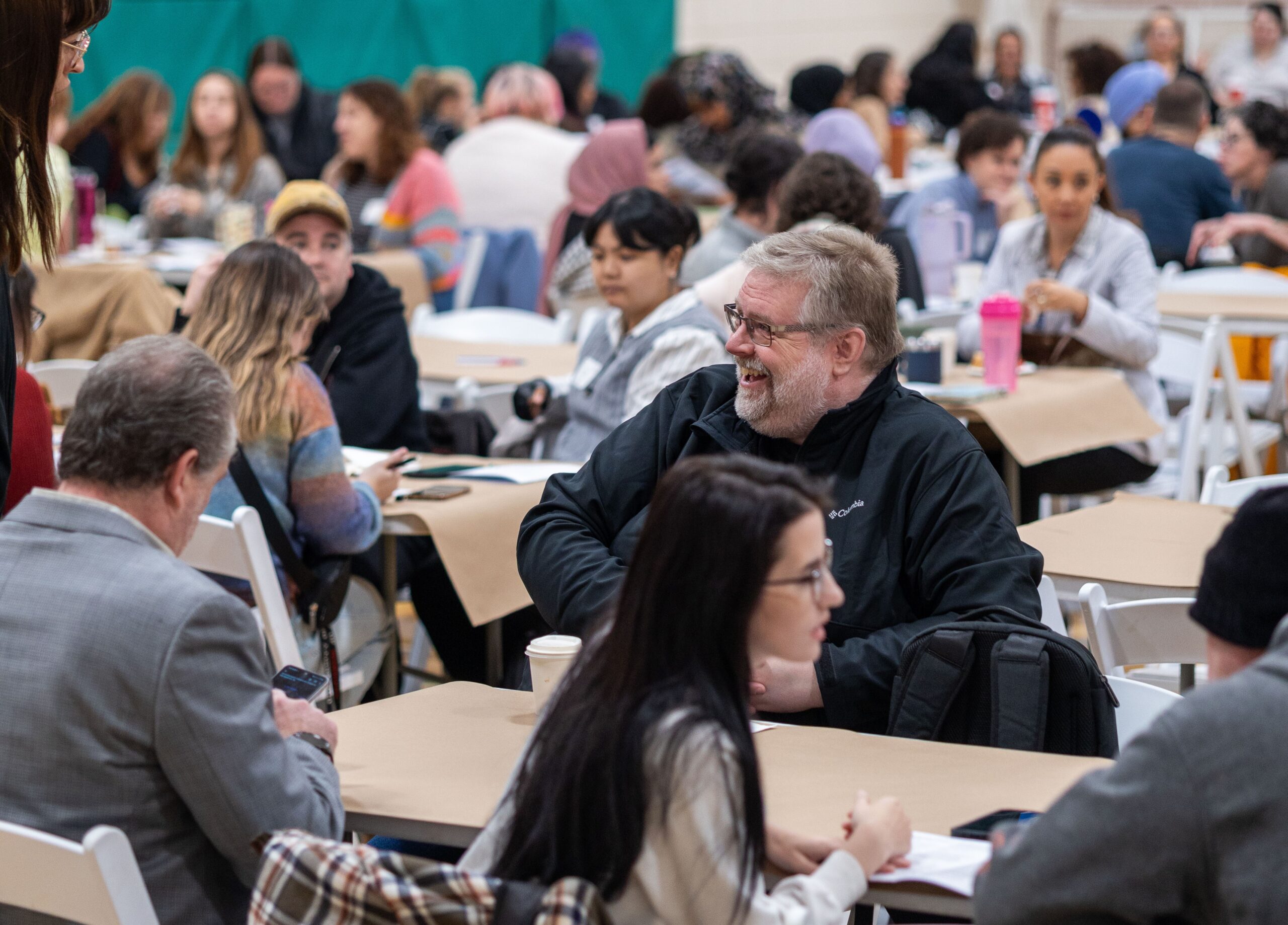 This summer, we’re sending teams of dedicated volunteers out to over 25 communities in Alberta to raise awareness about renewable energy, and to make the case that Alberta has the capacity to ensure “Solar 4 All.”
This summer, we’re sending teams of dedicated volunteers out to over 25 communities in Alberta to raise awareness about renewable energy, and to make the case that Alberta has the capacity to ensure “Solar 4 All.”
But what do we mean when we say we want solar for all? And why is it important?
The short of it is that while the “sun shines on everyone” (especially Albertans!), we don’t all have the same ability to tap into solar power and to reap the rewards. As Alberta moves to phase-out coal and introduce more renewables onto its grid, we have a unique opportunity to change not just how our power is generated, but also how it is owned and who and how many get to benefit. If we get it right, we’ll not only gain renewable energy, but also a more resilient and democratic economy.
A renewable energy program that fosters growth in small-scale and community-owned large-scale renewable energy will maximize the benefits of Alberta’s electricity grid transition for everyone.
Attaining those maximum benefits, however, means seeing our electricity system a bit differently. For most of us, energy is an essential good we pay for, but whether or not the power comes from a big coal plant, a wind turbine or a solar panel, or whether the profits go to a multinational company or a local provider isn’t something we question.
Similarly, food is also an essential good we pay for, but we tend to have a more holistic and nuanced understanding of it than we do about electricity. We buy the vast majority of our calories from grocers, but many of us produce some of our own food through gardening. We also know that there is a qualitative difference between a diet geared solely towards calories – 100% pixie sticks! – and one based around nourishment, health, and enjoyment with family, friends and community. The tremendous popularity of Farmer’s Markets in the province indicates that many of us also value purchasing our food locally, and developing relationships with those that produce it. Lastly, many of us understand that access to food – whether due to chronic or temporary poverty, or in times of crisis or disaster – is a problem for many Albertans, and one that we need to work together to overcome.
In other words, while we need calories, we understand that food is more than that – it’s about personal and ecosystem health. It’s about socializing, sharing and learning. Sometimes it’s about supporting the small guys and gals who work hard to produce our food locally, or the people that are unable to access adequate food. It can also be about producing it on our own, if we choose.
Just the same, we need to think about Alberta’s renewable transition as more than just green electrons. While utility-scale renewable energy generation will be a critical part of a sustainable grid, renewables owned and operated by individuals, small businesses and communities, First Nations and Métis settlements can serve an important and prominent role in meeting the province’s energy needs, while offering distinct additional benefits as well.
WHY SOLAR?
Alberta has high natural potential for solar. Calgary is the sunniest major city in Canada – as sunny as Miami, Florida. And a solar system in Edmonton, the third sunniest major city in the country, produces the same amount of energy as a system in Rio de Janeiro, Brazil.
But just as critically, it’s sunny everywhere in Alberta, so solar PV systems are suitable across the province. While Alberta’s best wind resources are concentrated in a few generally rural areas, the entire province has high potential for solar PV, includes urban areas. This means that most Albertans have a quality natural solar resource in close proximity, so communities and individuals could benefit from an on-site or nearby solar installation.
Because of its natural potential across the province, solar power creates an opportunity for everyone – individuals, neighbourhoods, First Nations/Métis communities, schools, farmer’s associations, municipal districts and other organizations – to lower their power bills, or even make income, while producing their own power and achieving energy sovereignty. Moreover, the fuel cost of solar is zero and maintenance costs are minimal, so solar PV systems can produce ongoing price stability for consumers.
Community-scale solar can also act as a vehicle for unrealized investment demand for renewable energy. For example, a share in Nelson, British Columbia’s solar garden – where ratepayers invest in panels as part of an installation owned by the municipal utility – costs $927 or less. The majority of Albertans don’t have the means to install a full system outright, even if they’d like to put some of their available savings into renewables. Investing in a solar farm jointly with neighbours is a way someone with a little money can strengthen their sense of community and shared purpose, while generating a return on investment. A community solar farm is the energy equivalent of the Oliver community garden in Edmonton, or the Varsity community garden in Calgary.
Solar also provides us a unique opportunity to create educational and community-building experiences. Solar tends to be highly visible in communities and the more contact people have with renewable energy, the more likely they are to approve of it, want it, and want to learn more about it. Once installed, community energy assets become a tool for energy education, built right into the very fabric of a community.
WHY FOR ALL?
Some people might say, “Why do we need special policies to make solar available to all Albertans? It is already is available to anyone that wants to put a system up on their roof.”
True, there is no legal restriction preventing an Alberta homeowner from installing solar on their property, or a First Nation from installing a large solar farm, if they follow certain rules. But, there’s a big difference between making something legal and creating a system that truly allows everyone to participate in a way that reflects our values of democracy and choice. The fact is, many Albertans don’t have the up-front money for a solar PV system, and many Albertans do not have the ability to install solar on their roof – either because they are apartment dwellers, or because they have an unsuitable roof. Indeed, most people find navigating the financial and regulatory system necessary to install solar PV quite daunting. Alberta’s Micro-Generation Regulation, the rules that enable homeowners to install Solar PV systems, creates some barriers itself. For example, the regulation does not allow the home or building owner to produce more energy than they consume per year: “the proposed production from a micro-generation unit cannot exceed a micro-generator’s annual electricity needs.”
So, despite the natural potential for all Albertans to tap into the benefits of solar power, there are many social and economic barriers to access for several segments of the population.
The main barriers Albertans face in procuring their electricity from self-produced solar PV are:
- Lack of access to the market and electricity grid (renters, condo-owners, or homeowners with unsuitable roofs, but also system size limits, and a lower price paid to homeowners than utilities at peak demand)
- Lack of technical capacity and start-up support (including navigating a complex of regulations)
- Lack of access to low-cost financing and better project economics (including available financing vehicles)
At the large scale, the current model – where power production is left to the open market – is really only open to those with easy access to large amounts of capital and/or the ability to make a detailed assessment of financial risk. Such a model not only limits the number of solar producers, but it fails to consider the multiple benefits a community ownership model of solar generation provides.
So while it is true that the “sun shines on everyone”, it is also true that we don’t all have the same ability to tap into that sun, and harness its energy. This means there is room for the Government to better enable solar by offering better access, capacity, and financing to Albertans who face barriers and prioritizing large scale solar projects that are fully or partially owned by communities, municipalities, farmer associations, First Nations and/or Métis Settlements. This is why we’re asking that the provincial government direct some of its climate leadership ambitions – policy, staff capacity, and some funding from the upcoming carbon levy – towards making solar accessible to everyone.
COMMUNITY SOLAR IS HERE AND GROWING!
Municipalities and coops are already leading the way in Alberta. The Town of Devon, for example, has a publicly owned Solar PV system mounted on the roof of its community centre that meets all of the facility’s energy needs. Starland County provided extensive technical support and capital subsidies to their “solar pioneers” – farmers who agreed to install arrays on their properties – in order to help them achieve a ten year payback. The Town of Banff provides residents and businesses with a seven year production-based subsidy for their solar PV installations, paid out of the rents utilities pay for right of ways. And finally, the Alberta Solar Co-op will allow individuals to invest RRSPs and TFSAs in a 2MW community-owned solar farm. These are just a few examples of the potential for distributed ownership of solar assets. But we need hundreds of more examples.
Solar power is a unique opportunity for everyone to benefit from Alberta’s transition towards a low-carbon economy. We need to make room for more Devons, more Banffs, more Alberta Solar Co-ops, and more Starland Counties.
Written by Emilia Kennedy and originally published by Greenpeace Canada on June 13, 2016
 Emilia Kennedy is an Advisor in Cross-Ministry Governance with the Alberta Climate Change Office. At the time this article was written, Emilia was a Government Relations and Policy Coordinator with Greenpeace. Emilia has a PhD in Human Geography from the University of British Columbia, where she studied climate and energy policy. In her academic and civic work she has always been interested in how categorization and spatial language (re)define the contours of the possible.
Emilia Kennedy is an Advisor in Cross-Ministry Governance with the Alberta Climate Change Office. At the time this article was written, Emilia was a Government Relations and Policy Coordinator with Greenpeace. Emilia has a PhD in Human Geography from the University of British Columbia, where she studied climate and energy policy. In her academic and civic work she has always been interested in how categorization and spatial language (re)define the contours of the possible.




